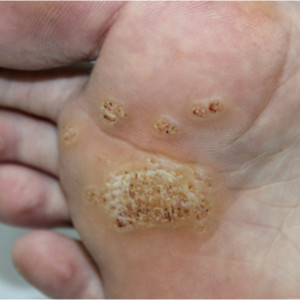
Plantar wart (Verruca plantaris)
Plantar warts are generally described as hard, calloused warts that occur mainly on pressure points on the sole of the foot and grow thorn-like in depth.
They have a rough surface and are sensitive to pressure. Plantar warts are especially common in swimming pools and public showers.
Unlike common warts (verrucae vulgares), plantar warts generally do not protrude much above the surface of the skin: because they are located on the sole of the foot or heel, the weight of the body rests on them.
This is why they cannot form hemispherical skin nodules (like common warts). Instead, plantar warts are pressed inwards: they usually reach deep into the subcutis. On the outside, only a somewhat thickened horny layer with a soft, smooth surface and a brownish-grey colour shows. The latter results from black dots standing close together. These are traces of leaking blood from superficial, very fine blood vessels (capillaries).
In conventional medicine, plantar warts are usually treated with a "patch containing salicylic acid" or "icing with liquid nitrogen" or, in the worst case, with surgery.
As a rule, plantar warts can be removed within 14 days using "alternative methods".
Do you want to know how?
Apply swabs saturated with 50 ppm colloidal silver and fix them overnight with sticking plaster.
In addition, drink 100 to 150 ml of colloidal silver at 25 ppm in the morning, at noon and in the evening for three days, then drink 100 to 150 ml twice a day until the symptoms improve
